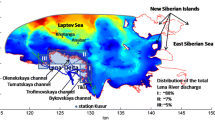Summary
Results obtained with a three dimensional baroclinic shelf sea model of the southern North Sea are compared with observations from a Rhodamine experiment near the Rhine mouth. For this purpose a transport model advecting conservative passive tracers according to the velocities calculated by the North Sea circulation model and adding a Monte Carlo diffusion is employed. Three different cases are simulated, namely a barotropic one, one prescribing dynamically balanced climatological monthly mean salinity distributions and one treating salinity fully prognostically including the source terms, i.e. accounting for river run off.
For the first few days of the Rhodamine experiment the currents calculated in the first two cases were oppositely directed to the fully prognostic run, with the latter in agreement with the observations. This suggests that in the specific situation of the experiment baroclinic pressure must have been dominant over barotropic pressure. Also, quite an effective self-advection of the fresh river water could be found in the simulations.
From the good simulation of the general circulation in the investigated area it is concluded that the front extending 15 to 50 km across the isohalines is responsible for the main impact on the mean circulation. The effect of the frequently observed meandering of the front due to instabilities on scales smaller than 10 km is apparantly parameterized correctly.
Zusammenfassung
Die Ergebnisse eines dreidimensionalen, baroklinen Schelfmodells der südlichen Nordsee werden mit Beobachtungen aus einem Rhodamin-Experiment an der Rheinmündung verglichen. Hierzu wird ein Transportmodell verwendet, das konservative, passive Tracer mittels der im Nordsee-Zirkulationsmodell berechneten Geschwindigkeiten advehiert und eine Monte-Carlo-Diffusion hinzuaddiert. Drei verschiedene Fälle wurden simuliert, nämlich erstens ein barotroper Modellauf, zweitens ein barokliner Modellauf unter Vorgabe dynamisch balancierter klimatologischer Mittelwerte für den Salzgehalt und schließlich ein Modellauf mit voll prognostischer Berechnung des Salzgehaltes unter Einbeziehung der Quellen, d. h. der Flüsse.
In den ersten Tagen des Rhodaminexperiments waren die berechneten Strömungen der beiden ersten Fälle denen aus dem prognostischen Lauf entgegengesetzt, wobei der letztere mit den Beobachtungen übereinstimmte. Das weist darauf hin, daß in dieser speziellen Situation der barokline Druck den barotropen dominiert haben muß. Außerdem konnte eine recht effektive Selbstadvektion des Frischwassers aus dem Rhein festgestellt werden.
Aus der guten Simulation der generellen Zirkulation im untersuchten Gebiet wird die Schlußfolgerung gezogen, daß die Front mit ihrer Ausdehnung von etwa 15 bis 20 km quer zu den Isohalinen den Haupteinfluß auf die mittlere Zirkulation darstellt. Die Auswirkungen der häufig beobachteten Mäander in der Front aufgrund von Instabilitäten auf der Skala unterhalb von 10 km werden offenbar angemessen parameterisiert.
Similar content being viewed by others
References
Backhaus, J. O., 1985: A three dimensional model for the simulation of shelf sea dynamics. Dt. hydrogr. Z.,38, 165–187.
Backhaus, J. O., 1990: On the atmospherically induced variability of the circulation of the north west European Shelf Sea and related phenomena—A model experiment. In: Modeling marine Systems. Vol. I. Es. A. M. Davies, Boca Raton. Florida: CRC Press, 93–134.
Becker, G. A., H. Frey und G. Wegner, 1986: Atlas der Temperatur an der Oberfläche der Nordsee, Dt. hydrogr. Z., Erg.-H. B17.
Bos, W. G. et al., 1992: Rhine plume experiment data Report HOLLAND surveys October 1990. Report DGW-92.020. The Hague: Rijkswaterstaat, Tidal Waters Division.
Damm, P., 1989: Klimatologischer Atlas des Salzgehaltes, der Temperatur und der Dichte der Nordsee, 1968–1985. Technical Report 6-89, pp. 1–81. Institut für Meereskunde der Universität Hamburg.
Damm, P., 1994: Persönliche Mitteilung
De Ruijter et al., 1992: Current and density structure in the Netherlands coastal zone,. In: Dynamics and exchanges in estuaries and the coastal zone. D. Prandle, Ed. Coastal and Estuarine Studies,40, 529–550.
Hainbucher et al., 1986: Atlas of climatological and actual seasonal circulation patterns in the North Sea Region and adjacent shelf regions 1969–1981. Technical Report 1-86. Institut für Meereskunde der Universität Hamburg.
James, I. D., 1991: Model Simulation of Eddies in the Norwegian Coastal Current. In: J. Phys. Oceanogr.21, 893 ff.
Kochergin, V. P., 1987: Three dimensional prognostic models. In: Three dimensional coastal ocean models. N. S. Heaps, Ed. Coastal and Estuarine Science,4, 201–208.
Luthardt, H. and L. Hasse, 1983: The relationship between pressure field and surface wind in the German Bight at high wind speeds. In: North Sea Dynamics. Ed. J. Sündermann and W. Lenz. Berlin: Springer, 340–348.
Maier-Reimer, E., 1973: Hydrodynamisch-numerische Untersuchungen zu horizontalen Ausbreitungs- und Transportvorgängen in der Nordsee. Mitt. d. Inst. f. Meereskunde d. Univ. Hamburg, 21.
Mellor, G. L. and P. A. Durbin, 1975: The structure and dynamics of the ocean surface mixed layer. J. Phys. Oceanogr.5, 718–728.
Otto, L. et al., 1990: Review of the physical oceanography of the North Sea. In: Neth. J. Sea Res.26, 161–238.
Pohlmann, Th., 1991: Untersuchung hydro- und thermodynamischer Prozesse in der Nordsee mit einem dreidimensionalen numerischen Modell. Ber. aus d. Zentrum f. Meeres- und Klimaforschung, d. Univ. Hamburg, 23.
Pohlmann, Th., 1994: Predicting the Thermocline in a Circulation Model of the North Sea. Part I: Model Description, calibration and verification. Cont. Shelf Res. (in press).
Suijlen, J. M. et al., 1990: Measurement of turbulent diffusion and residual displacements by dye experiments in the Southern North Sea in 1982. Data report, GWAO 90.023, unpubl. manuscript.
Suijlen, J. M. et al., 1990a: Dekker determination of the dispersal of Rhine water in the North Sea and the N. E. Atlantic by measurement of fluorescent xenobiotic river substances (XTRANS). Final Report, Mast 90.051C.
Weidemann, H. (Edt.), 1970: The ICES Diffusion Experiment RHENO 1965. Cons. Int. pour l'Explor. de la Mer. Rapp. et Proc. Verb. des Reun.,163, 1–111.
Author information
Authors and Affiliations
Rights and permissions
About this article
Cite this article
Langenberg, H., Pohlmann, T. The effect of a front on the general circulation—A model study of the Rhine plume area. Deutsche Hydrographische Zeitschrift 46, 341–353 (1994). https://doi.org/10.1007/BF02226310
Received:
Accepted:
Published:
Issue Date:
DOI: https://doi.org/10.1007/BF02226310




